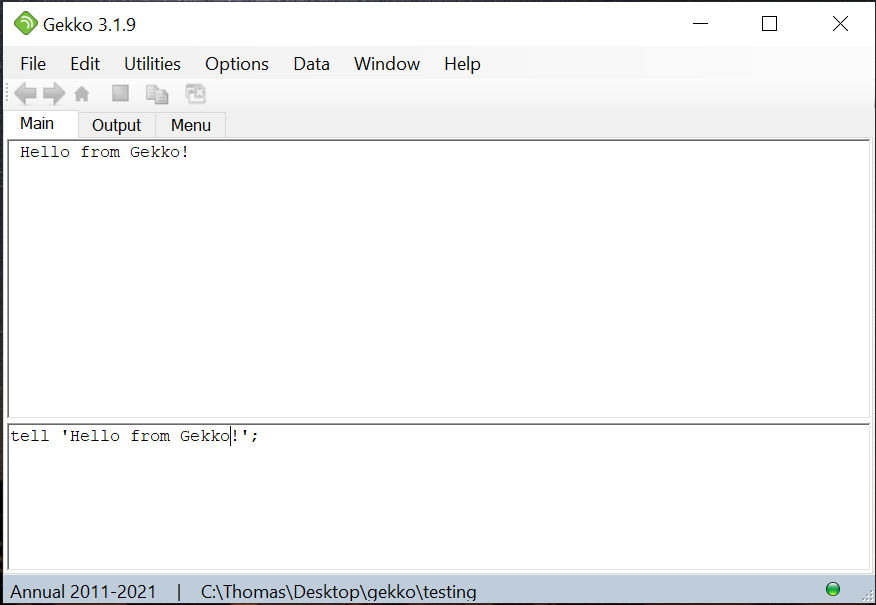|
<< Click to Display Table of Contents >> User interface |
  
|
|
<< Click to Display Table of Contents >> User interface |
  
|
The Gekko GUI (graphical user interface) looks as follows:

There are 3 tabs: "Main", "Output" and "Menu". The main tab is divided into two parts: the lower part is the command input window, and the upper part is the command output window. The output tab is sometimes used to show detailed lists etc, so that these do not clutter the main output window. The menu tab is for showing user-designed menus and tables. You may jump between the tabs by means of Ctrl+M, Ctrl+O and Ctrl+U.
Help on a particular statement is also available by means of typing help; or help [statement name]; in the statement prompt (or you may press F1). The bottom bar shows the current global time period, loaded databanks, and current working folder. At the right-side of the bottom bar are red, yellow or green "traffic lights". Green means that Gekko ended the job successfully and awaits new input, red means that Gekko encountered an error and awaits new input, and yellow means that Gekko is working on a job. You can double click on the traffic light to see a list of currently executing jobs (practical for tracking the progress of long-running jobs).
You may use the F2 key to see the list of open databanks.
List of function keys etc.
Function keys are used for quick access to specific Gekko statements. At the moment, only a few function keys are active.
F1 |
Opens up the help system. You can also type for instance help; or help sim; from the command line, in the latter case you will get help on that particular statement (SIM). |
F2 |
Opens up the databanks window (close with Esc). Note that the Ref, Local and Global databanks do not show up in this window if they are empty. You may also use SERIES? to see what kinds of timeseries the databanks contain. |
Tab |
Starts variable autocompletion: first place the cursor at the (partial) variable name. Gekko will try to match the variable name, and will show a list of matching names to choose from. You may use autocomplete on a variable like ab, where Gekko will try to match the pattern ab* (Gekko implicitly adds the trailing *). You may also add a databank name, like bank1:ab to look for ab* in bank1. You may set * or ? wildcards explicitly, but in that case Gekko will not add any trailing * on itself. Symbols @ (Ref databank) or ! (frequency) can be used, and array-series can be searched by using autocomplete on for instance the partial name x[ab to match all x[ab*], or on x[, which will match all x[**] (returns all elements of the arrayseries, regardless of the number of dimensions). Autocomplete looks in open databanks and only works on timeseries names, not scalar or collection names. The list of matching names contain labels as popups.
Note that [Ctrl+Space] can be used, too. Autocomplete uses the INDEX statement internally. Anything that can be used as input for the INDEX statement can be used for autocomplete, too. |
Enter |
If you hit [Enter] on a line without trailing ;, Gekko will automatically add the ; for you. If you hit [Enter] in the middle of a line not ending with ;, Gekko will complain and not add the ; automatically.
Note that with option interface edit style = ... , you may swap the use of [Enter] vs. [Ctrl+Enter]. |
Ctrl+Enter |
New line in command prompt, without issuing the command line.
Note that with option interface edit style = ... , you may swap the use of [Enter] vs. [Ctrl+Enter]. |
Ctrl+Space |
Starts variable autocomplete, cf. [Tab] above. |
Mark+Enter |
You may mark several lines in the Main window and execute them as one block with [Enter]. This is functionally equivalent to putting the lines in a Gekko program file (.gcm) and executing them with RUN.
Note that with option interface edit style = ... , you may swap the use of [Enter] versus [Ctrl+Enter]. |
Ctrl+M |
Jump to Main tab. |
Ctrl+O |
Jump to Output tab. |
Ctrl+U |
Jump to Menu tab. |
As mentioned, you may double-click the 'traffic light' indicator in the lower right of the interface to open up the 'Run status' window.
The left- and right arrow buttons below the menu are for browsing back and forth when showing DISP (equation browser), or when showing tables by means of menus. The 'home' button navigates back to the start.
The 'Stop current job' red button tries to halt an executing job.
The 'Copy last ...' button/icon at the top of the main Gekko window copies the last PRT/MULPRT, table, matrix, etc. as spreadsheet cells on the clipboard, for subsequent pasting into a spreadsheet (similar to CLIP). This is convenient for copy-pasting to for instance Excel.
There is also a button to close all PLOT and DECOMP windows at once.